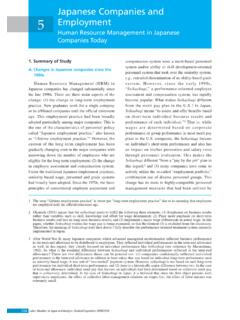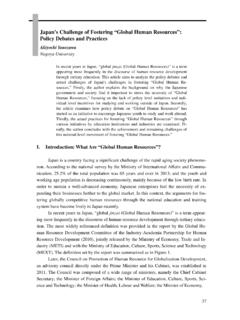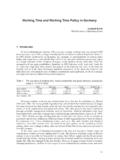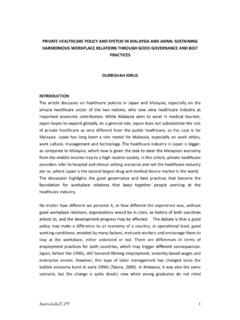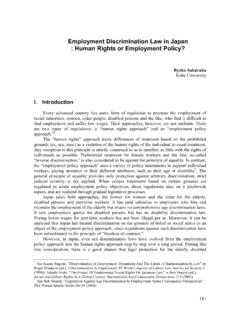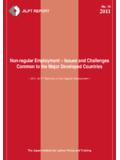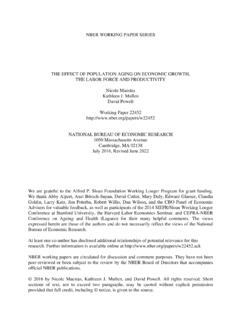Transcription of Malaysia|Changes in Employment Structure in Malaysia: The ...
1 77 Japan labor Issues, , , August-September 2018I. IntroductionThe Malaysian economy recorded remarkable growth throughout the post-independence period. Between 1980 and 2015, Malaysia s GNI per capita increased close to sixfold from USD1,790 in 1980 to USD10,570, well above the average of other upper-middle-income countries (World Bank 2016). Among the developing countries in the ASEAN region, the GNI per capita for Malaysia is the Malaysia gained independence in 1957, the country s real GDP growth accelerated from to (1966) before declining to in 1970. During this period, living standards improved, while the access to health care and education increased.
2 In the 1970s, the government promoted export-oriented industries which saw significant growth in the manufacturing sector. From 1971 to 1980, the economy grew at an average annual rate of In the 1980s, the prolonged global recession resulted in a sharp fall of commodity prices and the average annual growth rate declines to From 1991 to 1996, the annual average growth rate registered a staggering as a result of heavy involvement of the private sector in the economy and an increased inflow of foreign direct investment. However, the country was affected by the Asian financial crisis in 1997 and later the world trade recession in Between 2002 and 2017, real GDP growth ranges from to with the exception of a negative growth in The Structure of the Malaysian economyIn the 1970s, there was a radical shift from inward-looking import substitution to outward-looking, export-oriented industrialization policies in Malaysia.
3 The country transitioned from a rural-based agricultural economy to urban-based industrial economy. The country experienced major growth in industries such as electronics, food processing, plastics, textiles and garments. In the 1980s, the services sector expanded rapidly, especially in the education sector and public administration. By 2016, the share of the services sector is the largest at , while the share of the manufacturing sector is (Table 1).Today, the advancement of technological innovation has continued to impact Employment Structure and 1. This discussion is drawn from Ang (2007).
4 Changes in Employment Structure in Malaysia: The Way ForwardBeatrice Fui Yee LIMI. IntroductionII. The Structure of the Malaysian economyIII. Overview of the Malaysian labor marketIV. Changes in social structureV. The future workforce in MalaysiaVI. Policies to increase female labor force participation in MalaysiaVII. ConclusionTable 1. Share of economic sectors in the gross domestic product (percentage of GDP), : World Bank labor Issues, , , August-September 201810. Malaysiaform. With the arrival of Industry , menial jobs will be replaced by automation. The manufacturing sector which relies heavily on foreign labor faces continuous challenge to increase efficiency and productivity through adoption of new technology.
5 There is a growing need for multi-skilled and multi-disciplined workers across all economic sectors. In the future, work is projected to be on-demand and project-based, replacing regular Overview of the Malaysian labor marketThe labor force participation rate in Malaysia for persons aged between 15 and 64 fluctuated between and from 19822 to 2016. Due to increasingly unstable commodity prices in the 1960s, the Malaysian government introduced policies to encourage export-oriented industries in the 1970s. This resulted in increased Employment in the economy which peaked in 1988 with a labor force participation rate of After 1997, there was a slight decrease of labor force participation rate from and it has fallen to in 2010 as a result of the slower growth in the country s economy post-Asian crisis (Department of Statistics Malaysia 2016; National Economic Advisory Council 2010).
6 However, labor force participation rate increased gradually beyond 2010. Meanwhile, the unemployment rate is in the same Not in the labor forceThe total number of persons in the labor force is million in 2016. A total of 7 million person ( of the population aged between 15 and 64 years) is not in the labor force in 2016. Almost half of this number are individuals between 15 and 24 years. The main reasons cited for not being in the labor force include still studying (43%) and housework or family responsibilities ( ). Other reasons include intend to pursue study ( ), disability ( ), not interested to work ( ) and retired ( ).
7 2. Educational attainmentThe education system in Malaysia is constantly being revised to keep up with the country s structural change, especially to meet the demand for skilled and knowledgeable workers. In terms of educational attainment (Figure 1), the majority of the labor force have secondary school qualifications (or million). This is followed by individuals with tertiary education ( million). In order to boost the economy of Malaysia, a better proportion of skilled workers is needed. In developed economics, skilled workers made up at least half of the total workforce.
8 The development of human capital is regarded as one of the most important pillar to the success of the National Transformation 2050 (TN50) which aims to transform the country into a calibre nation state with par excellent mindset. The Malaysia Education Blueprint 2015-2025 was designed to increase access to education. By 2025, the Ministry of Higher Education aspires to increase tertiary education enrolment to 53%. At the same time, the Ministry promotes the TVET (Technical and Vocational Education and Training) pathways to develop skilled talent to meet the growing and changing demands of industry (Ministry of Education Malaysia 2015).
9 3. labor force participation by sexThe female labor force participation rate is historically lower than the male participation rate in Malaysia. Between 1970 and 1980, the female labor force participation rate increased significantly from to However, the rate showed a modest change from 40% to 49% from 1982 to 2012. In 2013, the female labor force participation rate surpassed the 50% mark for the first time and it hit an all-time high in 2016 at On the other hand, the male labor force participation rate was in 1982 and this has decreased over the decades to in 2011. In 2016, male labor force participation rate is The gender gap in labor force participation has narrowed between 1982 and 2015 from to Although this is a positive indicator 2.
10 Time series data from the Labour force Survey is only available from 1982 onwards. The data was not collected in 1991 and labor Issues, , , August-September 2018 The 2nd JILPT Tokyo Comparative labor Policy Seminar 2018for women s development, it should be noted that the closing of the gender gap is partly attributed to the decline in male labor force participation . Nonetheless, the primary reason behind the increasing number of women in the workforce is rising educational attainment among educational attainment in Malaysia has increased substantially in the post-independence era. Female adult literacy (among population aged 15 years and older) increased from in 1980 to in 2010 (UNESCO-UIS 2016).
